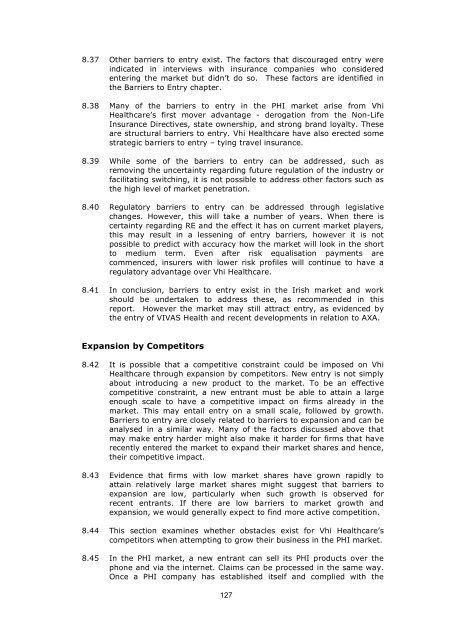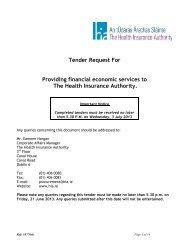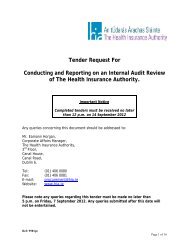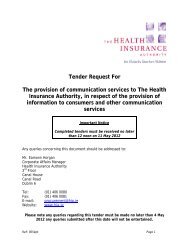Competition in the Irish Private Health Insurance Market
Competition in the Irish Private Health Insurance Market
Competition in the Irish Private Health Insurance Market
You also want an ePaper? Increase the reach of your titles
YUMPU automatically turns print PDFs into web optimized ePapers that Google loves.
8.37 O<strong>the</strong>r barriers to entry exist. The factors that discouraged entry were<br />
<strong>in</strong>dicated <strong>in</strong> <strong>in</strong>terviews with <strong>in</strong>surance companies who considered<br />
enter<strong>in</strong>g <strong>the</strong> market but didn’t do so. These factors are identified <strong>in</strong><br />
<strong>the</strong> Barriers to Entry chapter.<br />
8.38 Many of <strong>the</strong> barriers to entry <strong>in</strong> <strong>the</strong> PHI market arise from Vhi<br />
<strong>Health</strong>care’s first mover advantage - derogation from <strong>the</strong> Non-Life<br />
<strong>Insurance</strong> Directives, state ownership, and strong brand loyalty. These<br />
are structural barriers to entry. Vhi <strong>Health</strong>care have also erected some<br />
strategic barriers to entry – ty<strong>in</strong>g travel <strong>in</strong>surance.<br />
8.39 While some of <strong>the</strong> barriers to entry can be addressed, such as<br />
remov<strong>in</strong>g <strong>the</strong> uncerta<strong>in</strong>ty regard<strong>in</strong>g future regulation of <strong>the</strong> <strong>in</strong>dustry or<br />
facilitat<strong>in</strong>g switch<strong>in</strong>g, it is not possible to address o<strong>the</strong>r factors such as<br />
<strong>the</strong> high level of market penetration.<br />
8.40 Regulatory barriers to entry can be addressed through legislative<br />
changes. However, this will take a number of years. When <strong>the</strong>re is<br />
certa<strong>in</strong>ty regard<strong>in</strong>g RE and <strong>the</strong> effect it has on current market players,<br />
this may result <strong>in</strong> a lessen<strong>in</strong>g of entry barriers, however it is not<br />
possible to predict with accuracy how <strong>the</strong> market will look <strong>in</strong> <strong>the</strong> short<br />
to medium term. Even after risk equalisation payments are<br />
commenced, <strong>in</strong>surers with lower risk profiles will cont<strong>in</strong>ue to have a<br />
regulatory advantage over Vhi <strong>Health</strong>care.<br />
8.41 In conclusion, barriers to entry exist <strong>in</strong> <strong>the</strong> <strong>Irish</strong> market and work<br />
should be undertaken to address <strong>the</strong>se, as recommended <strong>in</strong> this<br />
report. However <strong>the</strong> market may still attract entry, as evidenced by<br />
<strong>the</strong> entry of VIVAS <strong>Health</strong> and recent developments <strong>in</strong> relation to AXA.<br />
Expansion by Competitors<br />
8.42 It is possible that a competitive constra<strong>in</strong>t could be imposed on Vhi<br />
<strong>Health</strong>care through expansion by competitors. New entry is not simply<br />
about <strong>in</strong>troduc<strong>in</strong>g a new product to <strong>the</strong> market. To be an effective<br />
competitive constra<strong>in</strong>t, a new entrant must be able to atta<strong>in</strong> a large<br />
enough scale to have a competitive impact on firms already <strong>in</strong> <strong>the</strong><br />
market. This may entail entry on a small scale, followed by growth.<br />
Barriers to entry are closely related to barriers to expansion and can be<br />
analysed <strong>in</strong> a similar way. Many of <strong>the</strong> factors discussed above that<br />
may make entry harder might also make it harder for firms that have<br />
recently entered <strong>the</strong> market to expand <strong>the</strong>ir market shares and hence,<br />
<strong>the</strong>ir competitive impact.<br />
8.43 Evidence that firms with low market shares have grown rapidly to<br />
atta<strong>in</strong> relatively large market shares might suggest that barriers to<br />
expansion are low, particularly when such growth is observed for<br />
recent entrants. If <strong>the</strong>re are low barriers to market growth and<br />
expansion, we would generally expect to f<strong>in</strong>d more active competition.<br />
8.44 This section exam<strong>in</strong>es whe<strong>the</strong>r obstacles exist for Vhi <strong>Health</strong>care’s<br />
competitors when attempt<strong>in</strong>g to grow <strong>the</strong>ir bus<strong>in</strong>ess <strong>in</strong> <strong>the</strong> PHI market.<br />
8.45 In <strong>the</strong> PHI market, a new entrant can sell its PHI products over <strong>the</strong><br />
phone and via <strong>the</strong> <strong>in</strong>ternet. Claims can be processed <strong>in</strong> <strong>the</strong> same way.<br />
Once a PHI company has established itself and complied with <strong>the</strong><br />
127







